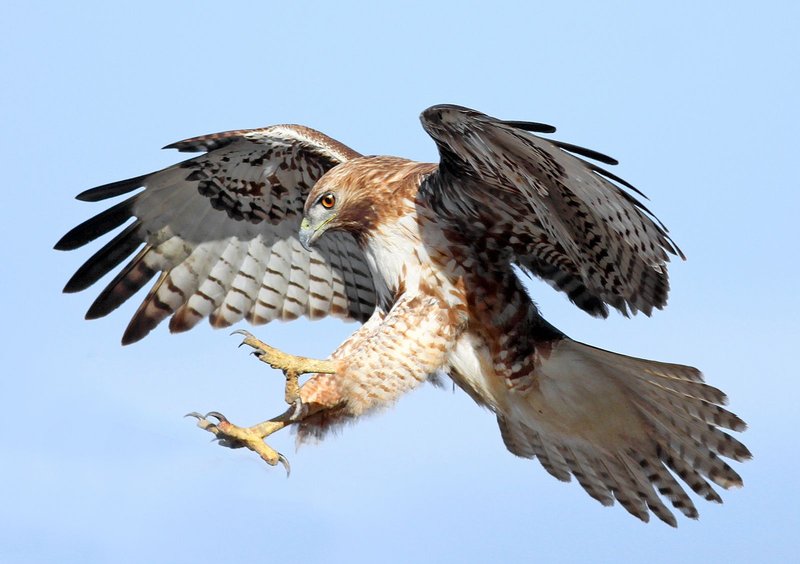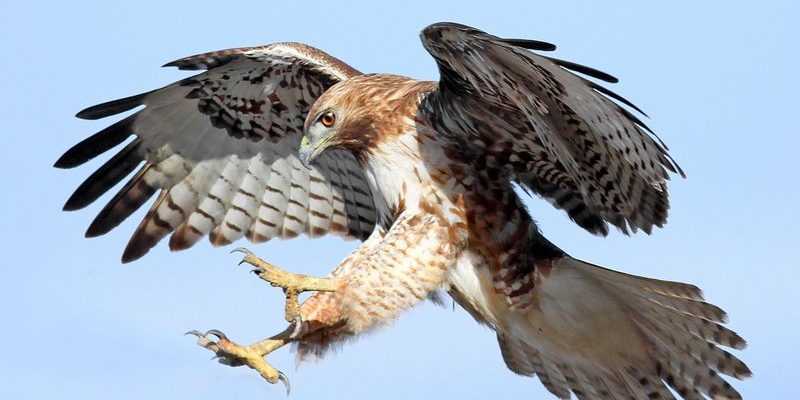
Red-tailed hawks are not just common in North America; they play an essential role in the ecosystem. They’re often seen perched on utility poles, trees, or even the odd fence post, keeping watch over the fields and forests. This blog will dive into ten fascinating facts about red-tailed hawks that will leave you more in awe of these incredible birds.
1. Recognizable by Their Signature Call
One of the most unique things about red-tailed hawks is their distinctive call. It’s that classic “kreeee” sound you often hear in movies where a hawk is circling overhead. This call isn’t just for show; it serves various purposes. Hawks use it to communicate with mates, warn off intruders, or signal their presence to other hawks.
You might be wondering why this call is so important. Well, in the wild, a hawk must quickly announce its location to avoid conflict and to attract a mate. Their vocalizations help maintain territory and ensure they can find each other in the vast expanse of their hunting grounds.
2. Their Diet is Varied and Impressive
Red-tailed hawks are opportunistic feeders, meaning they eat a wide range of prey based on what’s available. Their diet primarily consists of small mammals like rodents and rabbits, but they won’t shy away from birds, reptiles, and even insects.
This adaptability in diet is crucial for survival. For instance, in urban areas, red-tailed hawks have been known to hunt pigeons or rats, while in rural settings, they might target voles or squirrels. Their powerful talons and sharp beaks are designed for catching and tearing their prey apart, allowing these hawks to thrive in various environments.
3. Amazing Vision for Spotting Prey
Here’s the thing: red-tailed hawks have some of the best eyesight in the animal kingdom. Their eyes are specially adapted to see colors and detect movement from incredible distances. They can spot a mouse from over a mile away!
This sharp vision is essential for hunting. Imagine you’re at a concert, and you’re trying to see the stage from the back. Now, think of how the hawk can see a tiny mouse scurrying across the ground while flying high above. This ability not only helps them find food but also keeps them safe from potential threats.
4. They Have Stunning Plumage
If you’ve ever caught a glimpse of a red-tailed hawk, you know how beautiful they are. Their plumage is a mixture of browns, whites, and rust colors, which helps them blend into their surroundings. This camouflage is key when hunting or nesting, as it protects them from predators and allows them to sneak up on their prey.
Every hawk has its unique color pattern, much like fingerprints in humans. The variations in their feathers can help bird watchers identify individual hawks. You might see a lighter or darker hawk depending on where you are, which is a fun reminder of their adaptability to different environments.
5. They’re Expert Flyers
Red-tailed hawks are born to soar. They can fly at altitudes of up to 3,000 feet and can glide for hours without flapping their wings. By using thermal updrafts, they gain altitude while conserving energy. It’s like a surfer riding a wave, effortlessly riding the currents of air.
Flying high isn’t just for show; it also helps them spot prey and navigate across vast territories. This skillful flying is essential for their lifestyle as they cover large areas in search of food and suitable nesting sites.
6. Nesting Habits Are Quite Fascinating
When it comes to nesting, red-tailed hawks are quite particular. They often build their nests high in trees or on cliffs to keep their young safe from ground predators. The nests are large structures made from sticks, lined with softer materials like grass or feathers. It’s like building a cozy home where they can raise their chicks.
Once they lay their eggs, both parents take turns incubating them, which typically lasts around 28 to 35 days. After hatching, the chicks rely on their parents for food and protection until they are old enough to fly and hunt on their own. It’s a heartwarming process that underscores their dedication to family.
7. They Can Live a Long Time
In the wild, red-tailed hawks typically live about 10 to 15 years, but many can live longer, especially in captivity where they are protected from predators and harsh weather. Some individuals have been known to live up to 30 years in human care.
Longevity in the wild often depends on various factors, including food availability, environmental conditions, and threats from other animals. You might be surprised to learn that their main threats are not just other birds but also habitat loss and human activity.
8. They’re Cultural Icons
Red-tailed hawks have a significant presence in various cultures and traditions. Many Native American tribes see them as symbols of power, freedom, and spiritual insight. Their ability to soar high with such grace makes them a source of inspiration.
You might even come across their image in art, literature, and storytelling, where they represent a connection between the earth and the heavens. It’s fascinating to think how these birds have touched lives and cultures across different regions and times.
9. They’re Conservation Success Stories
Thanks to conservation efforts, the red-tailed hawk population has remained stable in many areas. While they face threats like habitat destruction and poisoning, ongoing efforts to protect their environments help ensure their survival.
Programs that educate the public about these beauties and create safe spaces for them have made a big difference. You might find yourself inspired to participate in local initiatives to protect the habitats that these magnificent birds call home.
10. They’re Part of a Greater Ecosystem
Red-tailed hawks aren’t just intriguing on their own; they play a crucial role in the ecosystem. As top predators, they help control populations of small mammals, preventing overpopulation that could lead to disease and competition for resources.
By maintaining this balance, they contribute to the health of their habitats. You might think of them as nature’s pest controllers, working silently yet efficiently to keep the environment thriving.
In conclusion, the red-tailed hawk is more than just a beautiful bird soaring in the sky. They are powerful hunters with fascinating behaviors and vital roles in our ecosystem. Whether you spot one perched high on a branch or gliding effortlessly above, take a moment to appreciate the wonders of this amazing bird!

